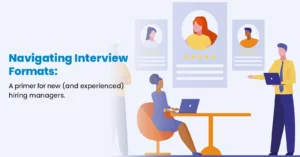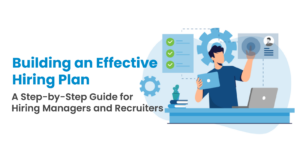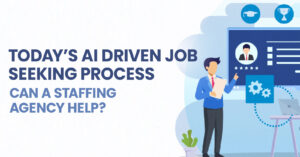It’s a tight labour market, and both Canadian and U.S. organizations are grappling with the challenges presented by a candidate controlled workforce. When there was once very little perceived pressure for employers to accommodate candidates during the hiring process, the tables have turned, and an intentional focus by employers on engaging talent with a candidate-driven approach is now essential to acquiring skilled contingent workers.
Why?
Because they can afford to be choosy, and employers can’t afford to remain stagnant in their hiring strategies if they want to remain competitive. Yet, only 7 per cent of organizations are doing it right: attracting qualified talent, quickly filling open positions (in under 10 days) and optimizing costs. However, a solid talent acquisition strategy will help employers pinpoint problem areas in their hiring programs and tap into why their choice candidates could be turning them down. And if you don’t have a talent acquisition strategy, now is the time to start—because the war for talent is getting harder to win.
The following considerations are areas we recommend employers evaluate in order keep candidates from rejecting offers.
Candidate experience
Candidates expect a unique experience, forcing organizations to work harder to attract and retain their attention. This means employers need to demonstrate their eagerness to hire and avoid poor hiring habits.
The following is a list of mistakes employers could be making that are turning off candidates:
• Communication lacks a personal touch and isn’t tailored to a candidate’s unique needs.
• The hiring process was too long and/or required too many interviews.
• The job description didn’t accurately portray the role once the candidate reached the interview stage.
• There’s a lack of communication between your organization and your staffing partner.
• The hiring manager didn’t effectively “sell the role or organization.”
Customer service tools
Tools like ClearlyRated can help improve your customer service and processes. These tools measure the NPS score a candidate gives at each stage of engagement (a satisfaction ranking of 1-10), easily allowing client service teams to take control in identifying areas in which the agency is exceeding candidate expectations and areas where it can do better, allowing for continuous improvement to the recruitment process and the client’s employers brand.
Negative employer branding
Negative employer branding makes it all the more difficult for organizations to engage talented workers, with 55 per cent of job seekers abandoning an application after reading a negative company review online. Yet, there are ways to improve your employer branding.
Glassdoor is a review website where previous and current workers can leave feedback on their employer, and it’s important for organizations to appoint a monitor to oversee their reviews ( yet only 45 per cent of organizations are doing so). The appointed monitor should also provide insights into how the organization will address the concern(s). If you’ve successfully taken the steps to resolve issues, data about trends in your improved reviews will be visible.
Ghosting
Communication with candidates at each stage of the hiring phase is key to keeping qualified talent engaged, yet some organizations are still going radio silent on candidates when they find others more qualified for the role. And it’s a mistake. As nearly a quarter of job seekers ( 23 per cent) will ghost a company who previously stopped communicating with them. And more than one-third (35 per cent) of job seekers find it very irresponsible for employers to go ghost.
• It’s imperative for hiring teams, recruiters and client service teams to actively return emails and phone calls within 24 hours or risk losing that resource to a timelier organization.
• Hiring teams need to follow up each communication with the next steps in the hiring process and what the expected timeline will be like.
• Nearly 40 per cent of job seekers (36 per cent) receive no response at all when a company rejects them. To expect engagement in the future, organizations and staffing agencies must have transparent communication with their candidates—even if it’s an awkward or uncomfortable conversation.
Competitive compensation
When it comes to making an offer, it’s critical to get an understanding of what’s important to your candidate by asking yourself, “What do they hope to gain out of the role, and where is the balance between what they’re looking for and the expected rate?”
• Ensure your rate card is up to date to reflect current market
• Consider non-monetary drivers unique to their requirements like remote work options, a flexible work schedule, exciting project work, career growth or the use of new technologies.
• Non-monetary drivers must include incentives relevant to what matters most to that candidate, because what is an attractive incentive to a Gen X worker won’t be as attractive to a Gen Z candidate.
Diversity and Inclusion (D&I)
Sixty seven per cent of job seekers say that a company’s level of diversity affects their decision to work there. For organizations that do have a D&I program, only 17 per cent consider Diversity and Inclusion as a key part of their EVP. And it’s a major mistake. Because younger workers are entering the workforce, and they’re the most diverse generation employed — with 77 per cent of Gen Zs stating that an organizations level of diversity affects their decision to work there.
Who are these diverse workers candidates want to see?
• Gender
• Ethnicity/race
• Lesbian, Gay, Bisexual, Transgender (LGBT)
• Military veterans
• Different ages
• Workers with disabilities
• Varying thinking styles
Organizations with inclusive cultures are twice as likely to meet or exceed financial targets, 3x more likely to be high-performing, 6x more likely to be innovative and agile and 8x more likely to achieve better business outcomes.
Identifying and understanding gaps in your current recruitment program is critical to designing a talent acquisition strategy that will effectively source, screen, onboard and redeploy contingent workers.
The Voice of Talent: Return to the Office Report
Procom recently surveyed over 1,000 knowledge workers to discover how and where they prefer to work as offices re-open across North America.
The Voice of Talent Report offers actionable insights into what workers expect in relation to mandatory vaccinations, remote work preferences, The Great Resignation, COVID-19 safety measures and more.
Access your complimentary copy to discover how to attract talent in a post pandemic world: {{cta(‘876b6743-23dc-425b-b245-80dba677a9c7′,’justifycenter’)}}




